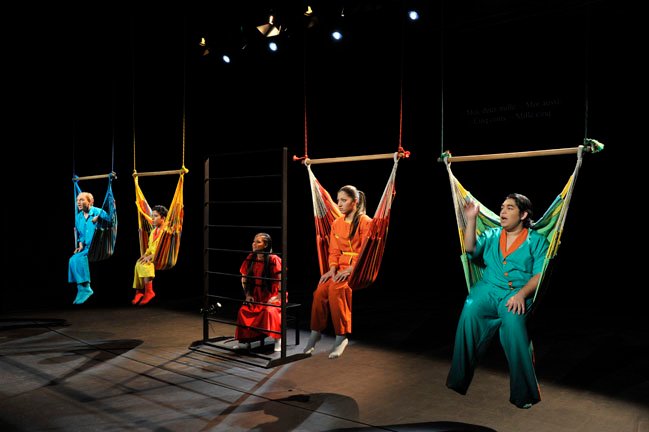
Should We Write Differently About Roma Theatre?
Consequently, the burning question is: what criteria can we use to decide that a performance really is “authentic representation?” When answering this question, the two approaches of aesthetics and heteronomy are inextricably mixed. If we think of Gayatri Chakravorty Spivak’s renowned essay Can the Subaltern Speak?, in which she writes both about the dangers of having others speak for those who have no voice, albeit with goodwill, and at the same time considers such a position utterly problematic, then we are seemingly talking about a purely ideological problem. But who could deny the theatrical power of someone who stands up on stage to speak for themselves? Moreover, to make things more complicated, several members of the workshop mentioned János Mohácsi’s show Just a Nail in 2008 as one of the most important Hungarian performances on Roma issues, even though its Roma characters were white.
Do we want to use art for confrontation…or would we rather place care at the center of the work?
At this point in the workshop, we began reflecting on the objectives of theatre. Do we want to use art for confrontation, to display current negative tendencies of how Roma are treated, or would we rather place care at the center of the work? In both cases, the question arises: what should we as members of the audience do about the problem of whether we are supposed to notice an actor’s skin color on stage or not? The historian Zoltán Imre, while preparing for the workshop, gave an account on a current trend in Anglo-Saxon theatres to use colorblind casting (or, as it has evolved further in past years, color conscious casting). This trend did not originate from the majority (white), but from the minority (Black, Asian, and others) artists, arguing that they would also like to be able to play King Lear—but if skin color matters, they are excluded from that opportunity. For a Black actor, Othello is almost the only option left in Shakespeare. As a spectator, however, it can be difficult to grasp—as in the Shakespeare’s Globe Theatre production a few years ago—that while Juliet was cast as a Black actress, her mother and father were played by white actors, and this had no consequences on their relationship in the production. A colorblind cast will most certainly require a new theatrical language. As a positive example of this phenomenon in Hungary, I think of performances of the Maladype company and the independent theatre director Zoltán Balázs. In Leonce and Lena in 2008, they used bamboo poles that required extreme physicality, technical skills, and concentration. I don’t remember having any thought of the skin color of protagonists Kamilla Fátyol and Hermina Fátyol. I was all the more in awe of what these actors were capable of, and this was likely due to the fact that this production spoke its own language.
The purpose of art and theatre has been, for many times in its history, to push the audience out of its comfort zone.
It is an axiom in identity politics not to talk on behalf of others, as every struggle belongs to the concerned group itself. This axiom raises fundamental questions with aesthetic consequences: are we writing about Roma self-representation or does the performance formulate from an external perspective? My personal opinion is that critics should not focus on “who,” but rather on “how?” Otherwise, we could only tell autobiographies. But here lie more delicate questions: should the critic take into account whether the performance is criticized by members of the oppressed group for reflecting badly on their already marginalized group? On the one hand, it would obviously be a mistake to treat some voices of objection as the official opinion of a diverse, and in many ways conflicting, group. But the diversity of individual sensitivities makes the debate endless. The purpose of art and theatre has been, for many times in its history, to push the audience out of its comfort zone. Peter Handke’s play Offending the Audience is a direct insult to its spectators. But of course, it referred to the theatre of a privileged social strata, the presumably middle-class spectator of bourgeois theatre, and not of an oppressed group. It was not about the oppressed group because they typically do not get to go to the theatre in the first place. Criticizing them in their absence is a little different from criticizing them face to face.




